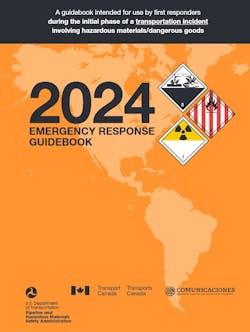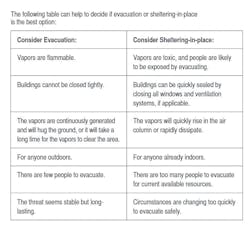The Emergency Response Guidebook (ERG) is an important resource for first responders when they are faced with hazmat incidents. The U.S. Department of Transportation (DOT) says that the ERG is “is intended for use during the initial phase of a transportation incident involving hazardous materials/dangerous goods.” Because there are vast differences in fire department resources, capabilities, exposures and training, assistance from hazmat teams might be hours away. Some emergency responders might have the ERG as their only resource. Therefore, there should be a copy in every emergency response vehicle, including fire, EMS and law enforcement.
Every four years, the DOT updates the ERG. What follows are changes to the 2024 edition that are important to know.
The White section
The Table of Markings, Labels and Placards section (pages 8–9) was changed to remove two obsolete designs on placards: triangular Marine Pollutant marking and yellow Division 5.2 placard. The latter was replaced by a red-over-yellow design.
The Rail Car Identification Chart (pages 10–11) was updated to include a cryogenic rail car. The DOT defines a cryogenic liquid, aka refrigerated liquid, as a liquid that has a boiling point that’s colder than -130 degrees Fahrenheit. Cryogenic liquids are made from compressed gases. There is no cryogenic hazard class. Hazards of cryogenic liquids are based on the hazard of the compressed gas that was liquefied. Cryogenic liquids can be flammable, oxidizers, asphyxiants and poisons.
The Road Trailer Identification Chart (pages 13–15) was updated to include new descriptive text for some of the configurations and types of road transport vehicles. Information that’s provided helps responders to know expected tank pressure range, hazards of materials that might be carried in the tanks and locations of fittings on each type of tank.
A table was added (page 284) in the Protective Action Decision Factors section to help responders decide whether evacuation or shelter-in-place is the best option. Protecting responders and the public is the No. 1 priority when hazardous materials, aka dangerous goods, are released and are potentially a danger to one or both. The new table speeds up the decision-making process, as dangers develop quickly during a hazmat release.
The Glossary was revised to include expanded listings: air-reactive; combustible control temperature; criticality safety index (CSI); evacuate; isolate; polar; self-heating material; self-reactive material; spontaneously combustible material; thermal runaway; water insoluble; water soluble; and clarified differentiation of solid stream and straight stream.
Liquid spill control methods
Also new to the 2024 ERG is the liquid spill control methods section. It includes guidance on the types and uses of absorbent materials and considerations for lithium battery and electric vehicle (EV) fires, including identification of damaged, defective or recalled (DDR) lithium batteries.
Chemical and biological warfare agents
Chemical and biological warfare agents considerations and all other information on these materials that were found throughout the former versions of the ERG were consolidated into a new Chemical and Biological Warfare Agents section that’s within the Criminal or Terrorist Use of Chemical, Biological and Radiological Agents section.
Chemical warfare agents (CWA) now are listed based on their type and symptoms, not by their name.
This new section includes a biological warfare agents table; a chemical warfare agents table; and initial isolation and protective action distances for CWA.
Yellow and Blue sections
None of the following changes and additions are likely to be recognized by responders who are researching chemicals, nor, in my opinion, is it necessary to memorize them. Nevertheless, it’s important to have the 2024 edition of the ERG and these listings.
Eleven new UN numbers for specific compounds are listed in the UN Model Recommendations on the Transport of Dangerous Goods and are assigned Orange guides. Materials were reevaluated to make sure that they are assigned to the appropriate Orange guide. Nineteen materials were moved to a different guide.
Chemical warfare agents:
- Removed the chemical warfare agents from the Yellow and Blue sections and incorporated them into the Criminal or Terrorist Use of Chemical, Biological and Radiological Agents section (see below).
- Added the polymerization hazard (P) to UN3302 (2-Dimethylaminoethyl acrylate, stabilized).
- Added a Liquid Spill Control Methods section, including guidance on the types and uses of absorbent materials.
- Removed the Chemical and Biological Warfare Agents Considerations section.
- As noted above, added a new Chemical and Biological Warfare Agents section in the Criminal or Terrorist Use of Chemical, Biological and Radiological Agents section.
Orange Section
The general first aid recommendations were moved to a new General First Aid section, which previously was found before Guide 111. Only material-specific recommendations were kept in the Orange Guide pages.
The following recommendations were added. Once again, I don’t believe that it’s necessary to memorize these.
- 115: Added caution statement for liquefied natural gas (LNG) released on/near water—“Product may vaporize explosively.”
- 131: Added Potential Health Hazard—“Methyl chloroacetate (UN2295) is an eye irritant/lachrymator (causes flow of tears).”
- 138, 159: Removed reference to Table 1.
- 140: Expanded guidance for ammonium nitrate products.
- 147: Revised firefighting recommendations for lithium-ion battery fires and added guidance for EV fires. Now includes sodium-ion batteries.
- 151: Added response guidance for spills of solid materials.
- 153: Added Potential Health Hazard—“Methyl bromoacetate (UN2643) is an eye irritant/lachrymator (causes flow of tears).”
- 156: Additional Response guidance—“For acetyl bromide (UN1716), use CO2 or dry chemical only.”
- 166: Added Potential Health Hazard—“Toxic; may be fatal if inhaled, ingested or absorbed through skin.” Revised Large Fire response guidance.
- 171: Added caution statement for delayed activation and projectile risk of safety devices (UN3268) and fire suppressant dispersing devices (UN3559).
Green Section
Table 1: Chemical Warfare Agents was removed. It was incorporated into the Criminal or Terrorist Use of Chemical, Biological and Radiological Agents section. Distances were revised. Table 3: Revised distances. In new editions of the ERG, distances often are revised when new information becomes available, such as from incidents where hazards extended farther than the current distance and computer modeling indicate.
Training on ERG use is essential
Although the ERG is a very helpful document for use at a hazmat incident, responders must be thoroughly trained in its use. It takes practice in a controlled setting to easily navigate the ERG at an emergency.
Training should include an overview of the contents of the ERG and multiple hands-on scenarios that require searching the Yellow, Blue, Orange and Green sections.
Most hazmat incidents involve common chemicals that are found in and transported through communities. For training, try to use examples of chemicals that are in your community or that are being transported through it. This is particularly important, because most emergency response agencies don’t respond to hazmat incidents on a regular basis.
Apps
The 2024 edition of the ERG is available as an app, for both iOS and Android devices, in English, French and Spanish. To download the app, you can locate the app by name in either the App Store (iOS) or Google Play (Android).
A PDF version of the ERG is available at the DOT ERG website—phmsa.dot.gov/training/hazmat/erg/emergency-response-guidebook-erg—as are lists of state agencies in each state that distribute the ERG free of charge to emergency response agencies.
About the Author

Robert Burke
Robert Burke, who is a hazardous materials and fire protection consultant and who served as a Firehouse contributing editor, is a Certified Fire Protection Specialist (CFSP), Fire Inspector II, Fire Inspector III, Fire Investigator and Hazardous Materials Specialist. He has served on state and county hazmat teams. Burke is the author of the textbooks "Hazardous Materials Chemistry for Emergency Responders," "Counter-Terrorism for Emergency Responders," "Fire Protection: Systems and Response," "Hazmat Teams Across America" and "Hazmatology: The Science of Hazardous Materials."




